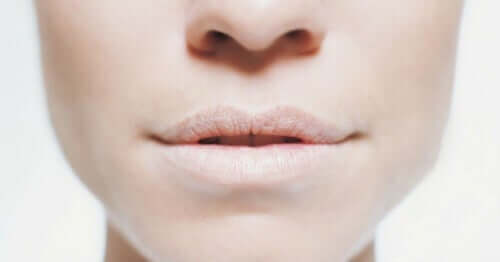All About Anhidrosis: The Inability to Sweat Normally

Anhidrosis is a condition characterized by an abnormal lack of sweat in response to heat. The sweat glands don’t produce sweat or don’t produce enough of it. It’s also known as hypohidrosis, adiaphoresis, or oligohidrosis, among others.
Anhidrosis can affect the entire body or only some parts. It’s a rare illness that can be difficult to diagnose at times.
However, it’s important to be aware of its possible symptoms, as it can be fatal. If the body doesn’t sweat, it can’t lower its temperature and could become excessively hot. In this article, we’ll tell you all about anhidrosis, as well as its causes.
All about anhidrosis: why does it occur?
Anhidrosis has numerous causes. This condition is most commonly due to skin trauma, such as burns, infections, or other injuries. It can also be caused by medication such as morphine or botox.
Other factors that can lead to this condition are:
- Congenital diseases. Certain dysplasias can affect the development of the sweat glands. The most prominent case is hypohidrotic ectodermal dysplasia. It also affects other ectodermal structures such as the skin, hair, and teeth.
- Metabolic diseases. For example, Fabry disease.
- Skin damage. As we mentioned above, burns can cause anhidrosis. In addition, radiation therapy or diseases such as psoriasis can also cause it.
- Nerve injury. Pathologies that damage the nerves (neuropathies), such as diabetes or Guillain-Barré syndrome, cause sweat gland dysfunction.
We should also note that anhidrosis can occur due to dehydration. Similarly, it can be caused by Sjögren syndrome, characterized by dry eyes and mucous membranes.

This article may interest you: 5 Things Your Sweat Says about Your Health
All about anhidrosis: the symptoms it causes
The main symptom of anhidrosis is the absence of sweat or not producing enough sweat. In addition, other symptoms such as dizziness and a warm feeling can occur, since sweat is the body’s way of regulating temperature.
Similarly, muscle cramps, weakness, and redness can occur in some areas, mostly on the face and neck.
There are two types of anhidrosis, depending on the body parts it affects:
- Partial anhidrosis. It occurs in a certain area. Maybe some healthy areas produce more sweat than normal.
- Total anhidrosis. Occurs throughout the body. This type causes much more serious symptoms. In fact, exercise and heat can lead to heat stroke in people who suffer from it.
Heat stroke
Heat stroke occurs when the body’s temperature exceeds 104°F. It’s an urgent situation. If it isn’t treated, it can damage different organs or even cause death.
At first, it causes confusion, delirium, nausea, and vomiting. Breathing and heart rate speed up. It’s necessary to act as soon as possible to lower body temperature and avoid body malfunction.
It’s worth mentioning that children are very vulnerable to heat stroke. This is because their internal temperature rises faster than that of adults. Also, their bodies release heat less effectively. Therefore, you must pay attention to these cases.

You may like this article: Discover Six Effects of Heat on the Body
How to diagnose anhidrosis
As we’ve mentioned above, this is usually a difficult condition to diagnose. Because of this, a doctor must take a good medical history and know all the symptoms.
In addition, additional tests such as a thermoregulatory sweat test (TST) can be requested. This consists of covering the patient with a powder that changes color in contact with sweat. The patient is placed in a camera that increases their body temperature and digital photographs observe whether they sweat or not.
Doctors can also request a skin biopsy, which is a more invasive technique. They usually request it in patients with partial anhidrosis.
All about anhidrosis: treatment
Treatment will depend on the cause of the condition. When it’s due to a drug, the patient needs to stop taking it. When the cause of anhidrosis is a blockage, the use of exfoliants sometimes helps unblock the sweat ducts.
Although this condition can’t be prevented, certain measures can help prevent heat stroke, for example. Firstly, it’s essential to wear light clothing and avoid sun exposure and vigorous physical activity on hot days. You can also use a spray bottle with water to cool off.
When the anhidrosis is partial, it usually doesn’t cause a problem nor require treatment. Nevertheless, it’s advisable to consult with a specialist so that they can assess the case.
Conclusion
Many different causes can lead to anhidrosis, which often goes unnoticed. If you notice any of the symptoms we mentioned here, don’t hesitate to see your doctor. They’ll request the pertinent tests and will propose the treatment or necessary measures to fight it.
All cited sources were thoroughly reviewed by our team to ensure their quality, reliability, currency, and validity. The bibliography of this article was considered reliable and of academic or scientific accuracy.
- Anhidrosis. Ausencia de sudoración. (n.d.). Retrieved June 5, 2019, from https://www.tuotromedico.com/temas/anhidrosis_sudoracion.htm
- Multimedia Encyclopedia – Penn State Hershey Medical Center – Sweating – absent – Penn State Hershey Medical Center. (n.d.). Retrieved June 5, 2019, from http://pennstatehershey.adam.com/content.aspx?productId=117&pid=1&gid=003219
- Definición de anhidrosis – Diccionario de cáncer – National Cancer Institute. (n.d.). Retrieved June 5, 2019, from https://www.cancer.gov/espanol/publicaciones/diccionario/def/anhidrosis
- Ausencia – sudoración: MedlinePlus enciclopedia médica. (n.d.). Retrieved June 5, 2019, from https://medlineplus.gov/spanish/ency/article/003219.htm
This text is provided for informational purposes only and does not replace consultation with a professional. If in doubt, consult your specialist.








